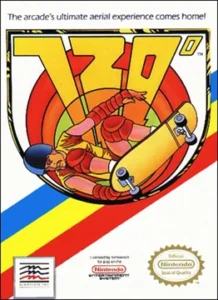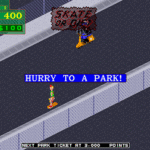 In the late 1980s, when Nintendo’s gray box ruled the world, 720° stood out like a scratched-up skateboard deck at a country club. Released for the NES in 1989 and adapted from Atari’s 1986 arcade hit, 720° was part sports game, part action-survival challenge—a punked-out, quarter-eating experience brought home to a console audience hungry for something edgier than football or racing. This wasn’t Ice Hockey or Rad Racer; this was the gritty, neon-soaked world of skateboarding culture, packed into 8 bits of attitude and chaos.
In the late 1980s, when Nintendo’s gray box ruled the world, 720° stood out like a scratched-up skateboard deck at a country club. Released for the NES in 1989 and adapted from Atari’s 1986 arcade hit, 720° was part sports game, part action-survival challenge—a punked-out, quarter-eating experience brought home to a console audience hungry for something edgier than football or racing. This wasn’t Ice Hockey or Rad Racer; this was the gritty, neon-soaked world of skateboarding culture, packed into 8 bits of attitude and chaos.
The NES port may have toned down some of the arcade’s speed and polish, but it captured that core energy—the thumping beats, the sense of freedom, and the ever-present threat of being swarmed by bees. (Yes, bees.) 720° was the first console game to make skateboarding feel dangerous, alive, and cool.
Plot: Skate or Die (Literally)
 You play as an unnamed skater dropped into a sprawling urban skate park filled with ramps, halfpipes, jumps, and hazards. The goal? Rack up points performing tricks, collect tickets, and enter one of four skate competitions before your timer runs out. Fail to make it to a park in time, and the ominous warning “SKATE OR DIE!” flashes across the screen as a swarm of killer bees descends to end your run.
You play as an unnamed skater dropped into a sprawling urban skate park filled with ramps, halfpipes, jumps, and hazards. The goal? Rack up points performing tricks, collect tickets, and enter one of four skate competitions before your timer runs out. Fail to make it to a park in time, and the ominous warning “SKATE OR DIE!” flashes across the screen as a swarm of killer bees descends to end your run.
It’s pure arcade mayhem disguised as a sports game—no storylines, no dialogue, just that constant drive to outmaneuver time, danger, and physics. Beneath its bright graphics, 720° was all about risk and reward: push your luck pulling off elaborate tricks, or play it safe and survive long enough to reach the next contest.
Controls and Gameplay: The Art of Momentum
At its core, 720° is all about mastering momentum. The game uses an isometric perspective—an angled view that gives you a pseudo-3D sense of space—and your skater moves with an almost slippery inertia. Every twist of the D-pad changes direction relative to the diagonal field, meaning beginners often spend their first few minutes skating straight into walls. But once you get the hang of it, it’s like learning to carve on an actual board—the game rewards rhythm, flow, and subtle control.
The two buttons control your tricks and jumps:
-
A Button: Jump off ramps or start an aerial trick.
-
B Button: Perform spins, flips, or slides, depending on your position.
Your trick repertoire grows as your score increases and your confidence builds. Spins, flips, ollies, grinds—it’s all here in primitive pixel form. What sets 720° apart is that it gives you freedom: you’re not just on a linear track, you’re skating through an open area full of ramps, rails, and secret zones.
Map Walkthrough: From the Streets to the Skate Parks
The world of 720° is divided into a central “City” hub area and four surrounding skate parks. You’ll need to explore the city to earn tickets and reach each park before time runs out. Here’s a breakdown of the terrain and the best paths to survival:
The City Hub
This is your playground—and your minefield. The city is filled with ramps, halfpipes, obstacles, and deadly open manholes waiting to send you flying. Collect pink and blue tickets scattered across the map to enter competitions. The timer constantly ticks down, so move fast.
Tips:
-
Keep an eye on the direction signs—they point toward the nearest skate park.
-
Avoid puddles and walls; hitting them slows your momentum and costs time.
-
Watch for jumps that lead to hidden tickets or shortcuts.
If your timer runs low, you’ll hear the infamous warning music: that buzzing, metallic drone that means the bees are coming. Once “SKATE OR DIE” appears, you have seconds to reach a park entrance. Miss it, and the swarm attacks—you’re done.
Ramp Park
The easiest of the four, the Ramp Park focuses on aerial tricks and speed. You’ll hit a series of halfpipes where you perform spins and jumps to rack up points.
Strategy: Focus on landing clean tricks and hitting every ramp in rhythm. Three or four perfect jumps can net enough points to pass the round.
Hazard: Over-rotating your spin causes a wipeout, costing precious seconds.
Downhill Park
This stage feels like a proto-Excitebike on skateboards. You’ll race downhill through a series of gates while avoiding rocks, cones, and curbs.
Strategy: Hug the sides early to avoid oncoming hazards, and jump over rocks whenever possible. Timing your jumps is crucial—each crash resets your speed.
Hazard: The gate timer—miss too many and your score tanks.
Slalom Park
Precision and control are everything here. You must weave through a tight series of flags while staying on course. The controls feel slippery, and even a single missed flag can make the difference between passing and failing.
Strategy: Don’t oversteer—tap the D-pad lightly and let the skater’s inertia carry you between flags.
Hazard: Overcorrection. The faster you go, the harder it is to stop.
Jump Park
The toughest of the four. This area demands long jumps, high airtime, and multi-spin tricks to earn enough points.
Strategy: Build speed before each jump, time your spin precisely, and land squarely. A clean landing doubles your score bonus.
Hazard: Missing the ramp edge—falling off means instant failure.
Level Progression and Scoring
After completing all four parks, you advance to a higher difficulty level where the timer shortens, the bees come faster, and the hazards increase. Each new cycle rewards more points but demands greater mastery of control.
Your final score depends on:
-
Trick variety (repeating tricks earns fewer points)
-
Combo landings (chain spins, flips, and jumps)
-
Time efficiency (the faster you reach a park, the better)
Getting the hang of these mechanics turns 720° into a flow-state experience—part speedrun, part score chase.
Cheat Codes and Secrets
720° doesn’t have traditional NES-style cheats, but there are a few hidden quirks and tricks:
-
Infinite Lives (Glitch): On some cartridge versions, pausing the game right as the bees appear and pressing A+B repeatedly can cause them to disappear for a few seconds, buying time to reach a park.
-
Hidden Points: Grinding certain fences repeatedly (especially near the lower-left corner of the city) occasionally triggers a “bonus trick” message, giving you extra points.
-
Skater Spin Bonus: Land a full 720° spin (two full rotations) cleanly, and you’ll get a secret sound effect and a score multiplier—hence the game’s title.
Enemies, Hazards, and That Bee
There are no human enemies in 720°, but the world itself is out to get you.
-
Cars and Pedestrians: Instant wipeouts.
-
Open Manholes: Drop in and you’re done.
-
Lakes and Puddles: Kill your momentum.
-
The Bee: The game’s most infamous threat. Once time runs low, the music changes, and a single bee appears—then another—then a full swarm. They zigzag across the screen, homing in until you either reach safety or die in buzzing shame.
The bee became a sort of cult symbol—arcade folklore at its finest. Players whispered theories: Was the bee a metaphor? A bug? A punishment? The truth is simpler—it’s a brilliant arcade trick to force urgency.
Graphics and Sound: Punk Pixel Paradise
For 1989, 720° looked cool. Its city hub was colorful and chaotic, filled with ramps, pools, and back alleys. The skater sprite had surprising fluidity, and the sense of depth in the isometric world was ambitious for the NES.
The soundtrack deserves its own shoutout: a series of funky, driving 8-bit tunes that sound like a fusion of synthwave and skate-punk. Each park has its own energetic theme, while the “SKATE OR DIE” warning music—shrill, dissonant, and terrifying—still gives longtime players flashbacks.
Legacy: The Birth of Skateboard Gaming
Before Tony Hawk’s Pro Skater made kickflips mainstream, 720° was there, defining the genre. It’s the grandfather of skate games—a mixture of style, danger, and arcade pacing that inspired a generation of developers. The title itself—“720°”—comes from the game’s ultimate trick: a double spin, which was virtually impossible to land cleanly without serious practice. That alone became a badge of honor for players who could pull it off.
While the NES port was a bit clunkier than its arcade predecessor, it preserved that wild, unpredictable energy. It wasn’t about realism; it was about rhythm, flow, and attitude. The kind of energy that makes you want to blast a cassette of Suicidal Tendencies and drop into a halfpipe at sunset.
Tips for Mastery
-
Master diagonal control early. The isometric view messes with new players—practice navigating corners before chasing big tricks.
-
Plan your route. The city is a maze; knowing where each park is saves time when the bees come.
-
Mix up tricks. Repetition kills your score bonus.
-
Ride momentum. Don’t fight the game’s inertia—use it to chain moves.
-
Listen for the warning tone. That buzzing means run.
Final Thoughts: A True 8-Bit Skate Classic
720° is the kind of game that perfectly encapsulates the NES era: bold, experimental, and slightly unhinged. It’s part sports sim, part arcade fever dream—a chaotic, endlessly replayable test of timing and nerves. While later skateboarding games would refine and expand the formula, 720° has a raw charm that’s never faded.
It’s not easy, it’s not forgiving, but it’s unforgettable. Whether you’re dodging bees or landing the mythical double spin, 720° is pure digital adrenaline—a love letter to motion, mastery, and the eternal grind.
Final Verdict:
🛹 720° remains a cult classic—an ambitious, maddening, exhilarating ride that paved the way for every skateboarding game that followed.